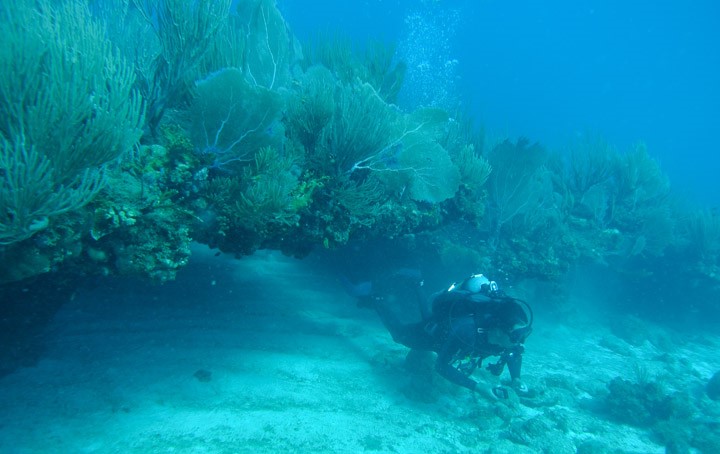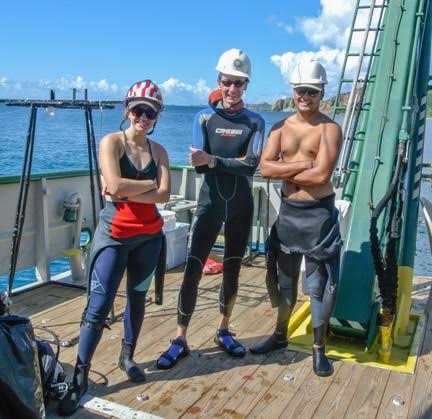Dr. Peter J. Edmunds, CSU Northridge
May 31, 2018
 Soft corals (6-m depth) are an important part of Caribbean reefs, and sampling from 2013-2017 suggested their success is due, in part, greater resilience to disturbances.
Soft corals (6-m depth) are an important part of Caribbean reefs, and sampling from 2013-2017 suggested their success is due, in part, greater resilience to disturbances.
In the
Anthopocene Epoch, the period of history shaped by humans, changes in biotic communities abound, and virtually all of them bear an unambiguous fingerprint of human disturbances. Quantifying these effects has become a frontier of modern ecology, for without a clear description of what has changed, it is impossible to forecast the future, or to propose management actions that have the potential to slow or prevent the changes that are underway. Some of the best examples of these principles are found on coral reefs throughout the world, many of which are vastly different now from just a few decades ago and potentially could disappear within the current century.
Together with teams of graduate and undergraduate students from CSU Northridge, we have been quantifying changes in coral reef communities in the U.S. Virgin Islands for 30 years, and this project provides one of the most detailed descriptions of changes on Caribbean reefs. Most of our work has focused on
stony corals in the
Virgin Islands National Park, but preliminary surveys conducted eight years ago suggested that
soft corals (another type of coral that is common on Caribbean reefs) seemed to be surviving better than stony corals. This observation led to a project funded by the U.S. National Science Foundation (NSF) to census soft corals on the same reefs, and to explore the likelihood that soft corals are more resilient to disturbances than stony corals. Due to a gap in federal support, COAST Rapid Response funding was secured to sample during the summer of 2017 to preserve the longevity of the time series. In July 2017, our research team headed to St. John to complete the annual survey work, and COAST support allowed CSU Northridge graduate student Sigfrido Zimmerman to join the group to conduct octocoral surveys and complete a portion of his MS research. Graduate students Ashley Potter and Arien Widrick, also from CSU Northridge, joined the team and assisted with the surveys.

Left to right: Graduate student Ashley Potter, Dr. Peter J. Edmunds,
graduate student Sigfrido Zimmerman.
Data collected in July and August 2017 are beginning to reveal the complex ways in which soft coral communities change through effects acting on populations of individual species of soft coral. Populations grow, in part, through the production of baby soft corals that grow near the adult soft corals, but when the populations become dense, signs of self-thinning begin to appear where big colonies reduce the success of near-by colonies. Our research also suggests that soft corals are more resilient than stony corals to select major disturbances, such as destructive hurricanes. However, in order to test this hypothesis we would have to simulate widespread destruction, which cannot be done in a national park.
 An over-turned boulder on the reefs of St. John in November 2017, with the soft coral on its former upper surface now prostrate and doomed to death.
An over-turned boulder on the reefs of St. John in November 2017, with the soft coral on its former upper surface now prostrate and doomed to death.
The 2017 sampling turned out to be particularly important because it provided data on the ecological condition of the coral reef communities prior to unpredictable events. In September 2017, St. John was devastated by twin Category 5 hurricanes, Hurricanes Irma and Maria. These storms, while devastating for the community, provided a scientific opportunity: because we had data from the time period immediately preceding the storms, we were able to evaluate how the coral reefs in the Virgin Islands National Park had been damaged. Effectively, these storms created the experiment (i.e., damage and loss of corals across a large area) that could not be conducted by researchers. When we surveyed the reefs just two months after the storms, we found at depths of 6 m or less, that there was extensive destruction including sand scour, broken hard coral, sponges and soft coral that had been ripped off the bottom, and 5- to 10-ton granite boulders that had been toppled. In deeper waters however, there was much less damage but corals, sea fans and many fishes were still present.
Support from COAST was critical in securing new funding from NSF to investigate
pattern and process in the abundance and recruitment of Caribbean octocorals. This four-year project in collaboration with
Dr. Howard Lasker, University at Buffalo, will allow us to assess the longer-term effects of major hurricanes on soft corals, as well as their recovery.
Dr. Peter J. Edmunds is a Professor of Biology at CSU Northridge. COAST provided funding for this project: Rapid Response Funding Program Award # COAST-RR-2016-04, April 2017.